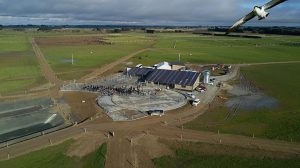
One of the topics they are asking me about more and more is what we are doing to reduce our emissions, and how we can help them to do the same. This is a core question for our co-op as we’ve made a strategic choice to lead in sustainability.
Today, New Zealand dairy leads the way in low-carbon agriculture, but we can’t sit still. We need to work together to maintain and strengthen this position as other countries and dairy companies are closing the gap. That’s why last year we signalled to farmers our intent to announce an on-farm emissions reduction target.
On-farm emissions account for 90% of our co-op’s total emissions and there are four key drivers for setting a reduction target:
• Our strategic choice to be a leader in sustainability
• Retain and support our high-value customers and ensure continued access to markets
• Retain access to funding and capital, for both the co-op and farmers’ businesses.
• Increased legal and external reporting obligations – disclosing and responding to climate-related risks, and External Reporting Board standards, will soon be a requirement for all major dairy processors in New Zealand.
Since the start of the year we have been talking to farmers about why we need a target, what a target may look like and how by working together we can achieve it.
These conversations are in addition to tools we already provide at no cost to farmers to boost their environmental performance and reduce their emissions. These include.
• Farm Environment Plans – our Sustainable Dairy Advisers work with farmers to help to deliver tailored plans that are sector leading and include time-bound actions to improve environmental outcomes.
• Farm Insights Reports – received by every co-op farmer, giving them information on their milk, animal and environmental performance. The reports include farm-specific greenhouse gas data, the first step in building our farmers’ awareness of their emissions profile. Specific optimisation opportunities in animal wellbeing and fertiliser use are also suggested to support the improvement of on-farm efficiencies.
We know that to maintain our relative carbon footprint advantage against the northern hemisphere farming system, we must work with others to solve the methane challenge and are doubling our innovation efforts to look for solutions. These include:
• The Centre for Climate Action on Agricultural Emissions joint venture with the government and other industry bodies. Around $172 million will be invested over the next four years in total, to develop and commercialise practical tools and technologies for farmers.
• The 18 different projects and more than 30 trials we have underway working to solve the biogenic methane challenge. One of the most exciting is the work to test if using asparagopsis seaweed as a supplement feed for dairy cows could reduce greenhouse gas emissions.
• Partnering with Nestlé to develop a commercially viable net-zero carbon emissions dairy farm, as well as working with them on a greenhouse gas farmer support pilot programme.
But the onus isn’t just on farmers – we also have targets to reduce the emissions from our site and transport operations as part of our ambition to be net zero by 2050. One of the most important initiatives to achieve these targets is to stop using coal in our manufacturing operations, and we have a target to do this by 2037.
Most of this work to get out of coal will be done by 2030 and by the end of this year we expect only six out of 29 manufacturing sites will still be using coal. In terms of transport, many of our tankers run on biodiesel and our innovative electric tanker Milk-E completed its first milk run in November last year.
The next step on our farmer engagement journey is to delve deeper with our farmers on the on-farm actions that can be taken today to reduce emissions. This will be supported by a guidance booklet that our farmers can choose to use alongside conversations with our field teams and other experts in the industry.
























